Sociology: Examining Social Problems and Key Social Institutions
VerifiedAdded on 2023/06/11
|5
|957
|499
Essay
AI Summary
This sociology essay provides an analysis of social problems in American society, focusing on homelessness through the lenses of functionalism, conflict theory, macrosociology, microsociology, and symbolic interactionism. It also explores the influence of social institutions, contrasting the significant roles of family and education with the lesser impacts of economics and politics. The essay leverages sociological theories to understand societal structures and individual interactions, offering a comprehensive perspective on the interconnectedness of social issues and institutional influences. Desklib offers a wealth of similar assignments and study tools to support students in their academic endeavors.
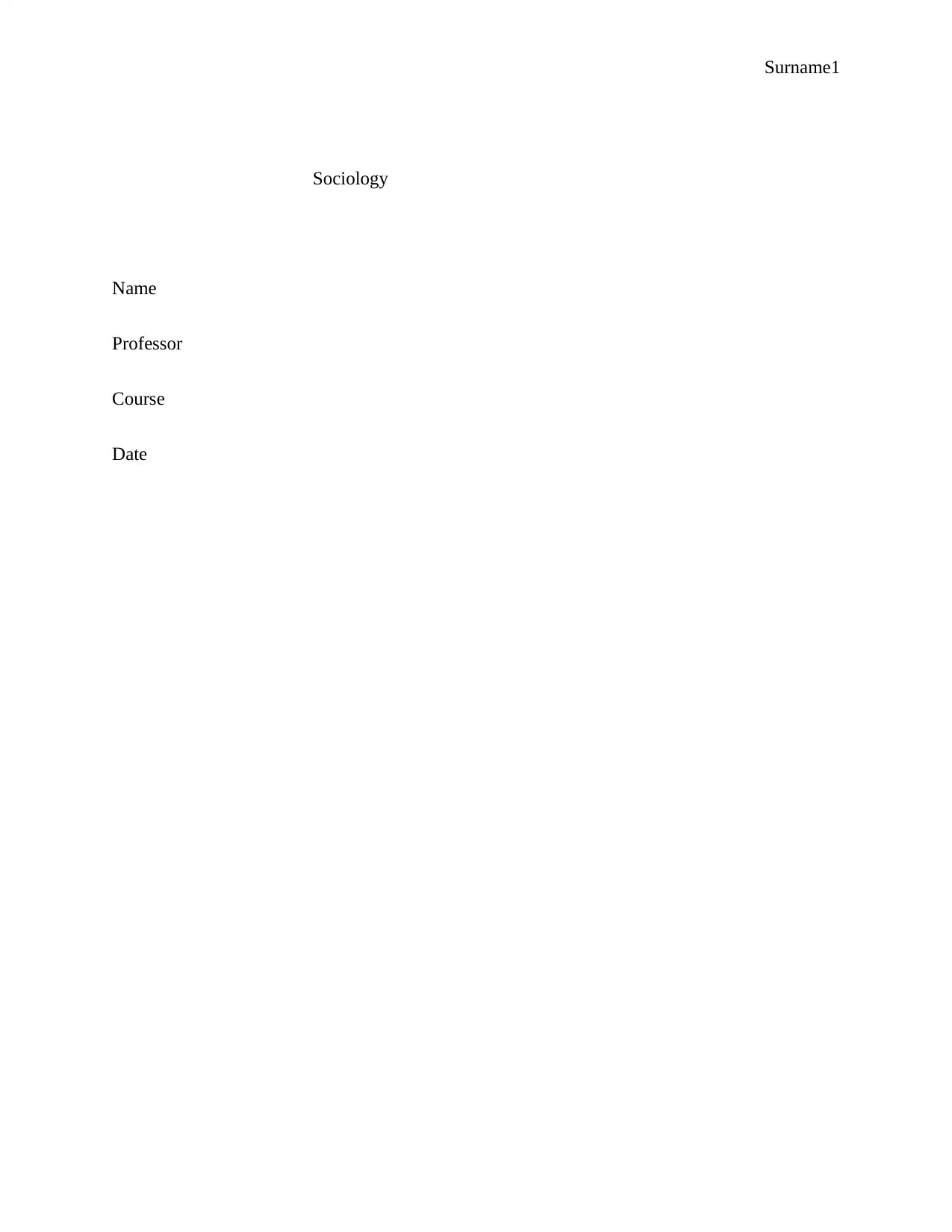
Surname1
Sociology
Name
Professor
Course
Date
Sociology
Name
Professor
Course
Date
Paraphrase This Document
Need a fresh take? Get an instant paraphrase of this document with our AI Paraphraser
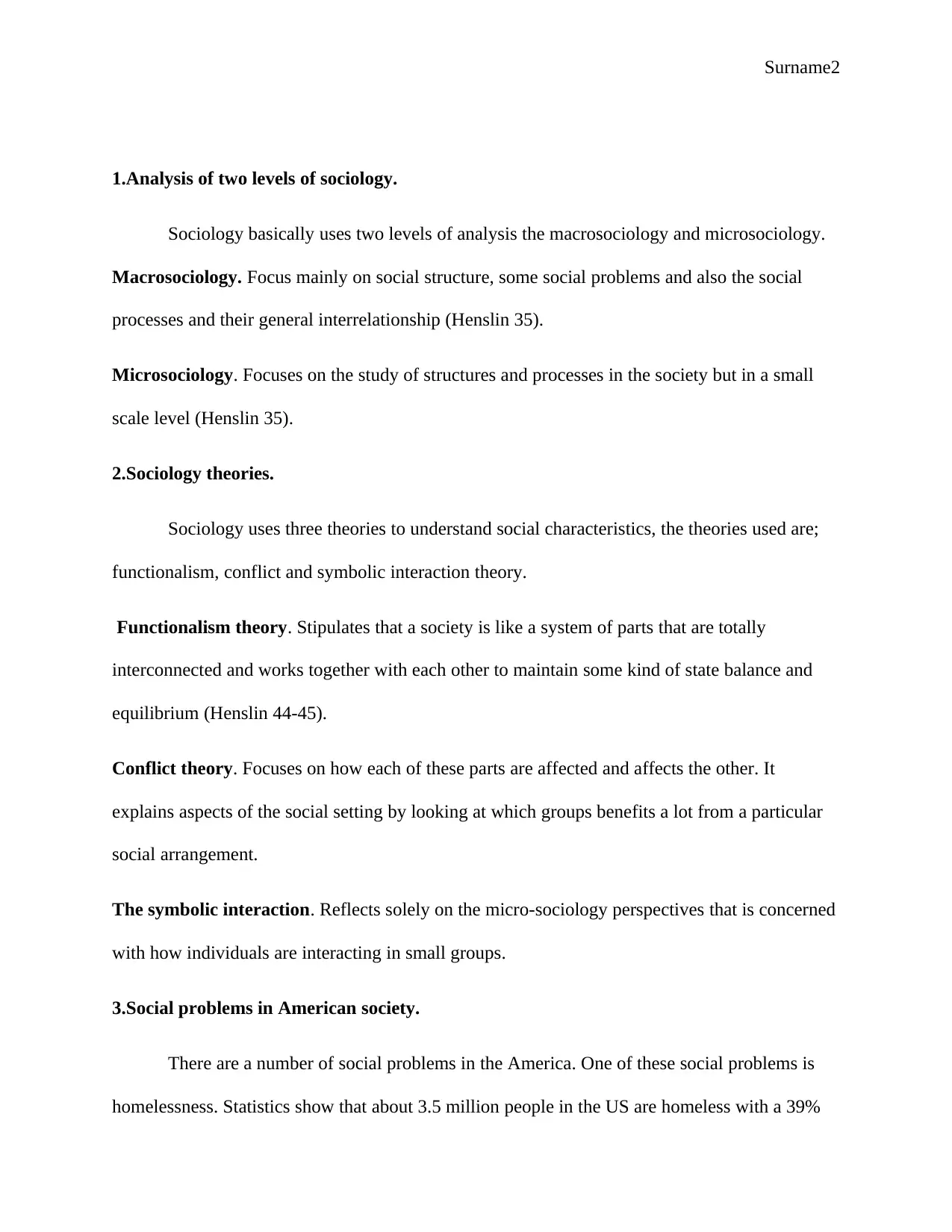
Surname2
1.Analysis of two levels of sociology.
Sociology basically uses two levels of analysis the macrosociology and microsociology.
Macrosociology. Focus mainly on social structure, some social problems and also the social
processes and their general interrelationship (Henslin 35).
Microsociology. Focuses on the study of structures and processes in the society but in a small
scale level (Henslin 35).
2.Sociology theories.
Sociology uses three theories to understand social characteristics, the theories used are;
functionalism, conflict and symbolic interaction theory.
Functionalism theory. Stipulates that a society is like a system of parts that are totally
interconnected and works together with each other to maintain some kind of state balance and
equilibrium (Henslin 44-45).
Conflict theory. Focuses on how each of these parts are affected and affects the other. It
explains aspects of the social setting by looking at which groups benefits a lot from a particular
social arrangement.
The symbolic interaction. Reflects solely on the micro-sociology perspectives that is concerned
with how individuals are interacting in small groups.
3.Social problems in American society.
There are a number of social problems in the America. One of these social problems is
homelessness. Statistics show that about 3.5 million people in the US are homeless with a 39%
1.Analysis of two levels of sociology.
Sociology basically uses two levels of analysis the macrosociology and microsociology.
Macrosociology. Focus mainly on social structure, some social problems and also the social
processes and their general interrelationship (Henslin 35).
Microsociology. Focuses on the study of structures and processes in the society but in a small
scale level (Henslin 35).
2.Sociology theories.
Sociology uses three theories to understand social characteristics, the theories used are;
functionalism, conflict and symbolic interaction theory.
Functionalism theory. Stipulates that a society is like a system of parts that are totally
interconnected and works together with each other to maintain some kind of state balance and
equilibrium (Henslin 44-45).
Conflict theory. Focuses on how each of these parts are affected and affects the other. It
explains aspects of the social setting by looking at which groups benefits a lot from a particular
social arrangement.
The symbolic interaction. Reflects solely on the micro-sociology perspectives that is concerned
with how individuals are interacting in small groups.
3.Social problems in American society.
There are a number of social problems in the America. One of these social problems is
homelessness. Statistics show that about 3.5 million people in the US are homeless with a 39%
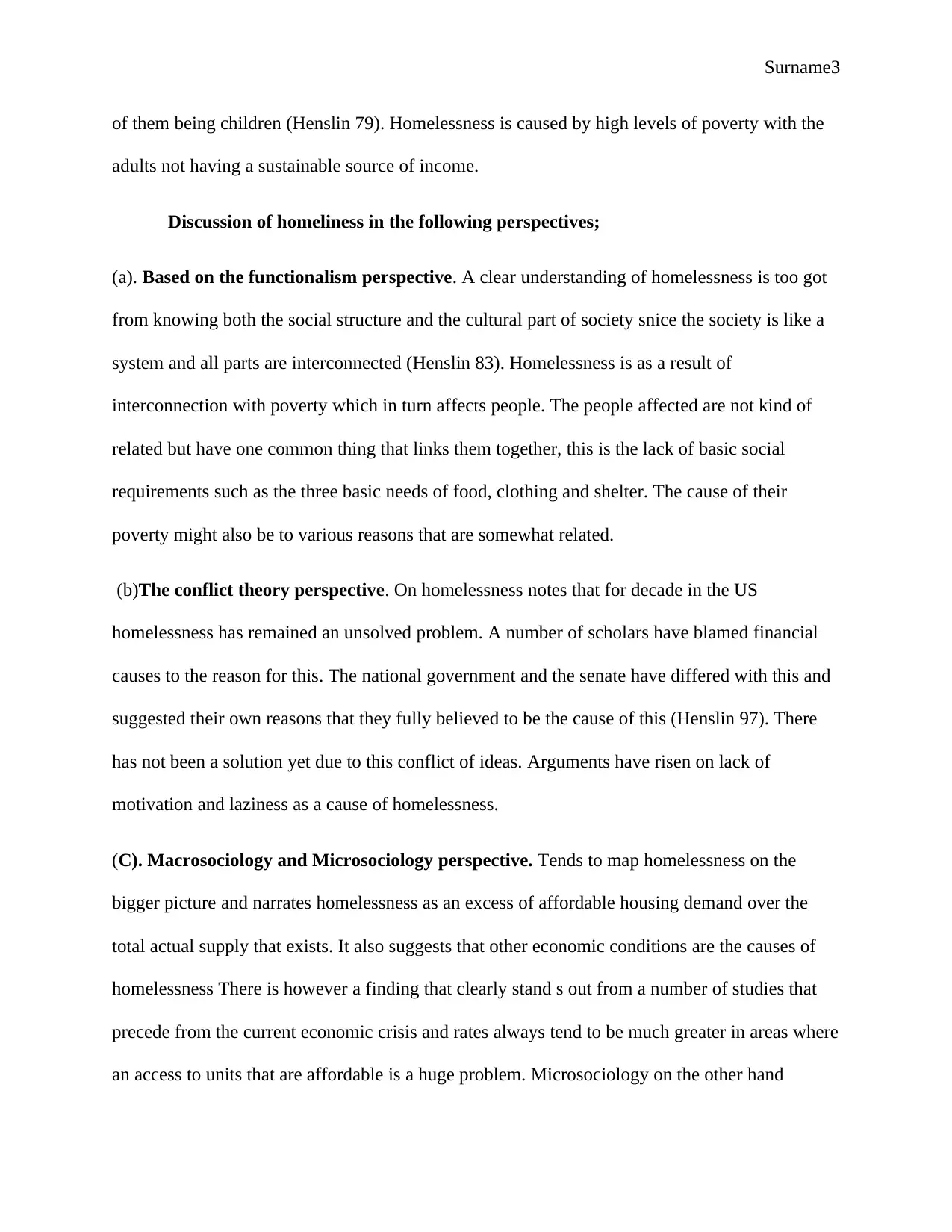
Surname3
of them being children (Henslin 79). Homelessness is caused by high levels of poverty with the
adults not having a sustainable source of income.
Discussion of homeliness in the following perspectives;
(a). Based on the functionalism perspective. A clear understanding of homelessness is too got
from knowing both the social structure and the cultural part of society snice the society is like a
system and all parts are interconnected (Henslin 83). Homelessness is as a result of
interconnection with poverty which in turn affects people. The people affected are not kind of
related but have one common thing that links them together, this is the lack of basic social
requirements such as the three basic needs of food, clothing and shelter. The cause of their
poverty might also be to various reasons that are somewhat related.
(b)The conflict theory perspective. On homelessness notes that for decade in the US
homelessness has remained an unsolved problem. A number of scholars have blamed financial
causes to the reason for this. The national government and the senate have differed with this and
suggested their own reasons that they fully believed to be the cause of this (Henslin 97). There
has not been a solution yet due to this conflict of ideas. Arguments have risen on lack of
motivation and laziness as a cause of homelessness.
(C). Macrosociology and Microsociology perspective. Tends to map homelessness on the
bigger picture and narrates homelessness as an excess of affordable housing demand over the
total actual supply that exists. It also suggests that other economic conditions are the causes of
homelessness There is however a finding that clearly stand s out from a number of studies that
precede from the current economic crisis and rates always tend to be much greater in areas where
an access to units that are affordable is a huge problem. Microsociology on the other hand
of them being children (Henslin 79). Homelessness is caused by high levels of poverty with the
adults not having a sustainable source of income.
Discussion of homeliness in the following perspectives;
(a). Based on the functionalism perspective. A clear understanding of homelessness is too got
from knowing both the social structure and the cultural part of society snice the society is like a
system and all parts are interconnected (Henslin 83). Homelessness is as a result of
interconnection with poverty which in turn affects people. The people affected are not kind of
related but have one common thing that links them together, this is the lack of basic social
requirements such as the three basic needs of food, clothing and shelter. The cause of their
poverty might also be to various reasons that are somewhat related.
(b)The conflict theory perspective. On homelessness notes that for decade in the US
homelessness has remained an unsolved problem. A number of scholars have blamed financial
causes to the reason for this. The national government and the senate have differed with this and
suggested their own reasons that they fully believed to be the cause of this (Henslin 97). There
has not been a solution yet due to this conflict of ideas. Arguments have risen on lack of
motivation and laziness as a cause of homelessness.
(C). Macrosociology and Microsociology perspective. Tends to map homelessness on the
bigger picture and narrates homelessness as an excess of affordable housing demand over the
total actual supply that exists. It also suggests that other economic conditions are the causes of
homelessness There is however a finding that clearly stand s out from a number of studies that
precede from the current economic crisis and rates always tend to be much greater in areas where
an access to units that are affordable is a huge problem. Microsociology on the other hand
⊘ This is a preview!⊘
Do you want full access?
Subscribe today to unlock all pages.

Trusted by 1+ million students worldwide
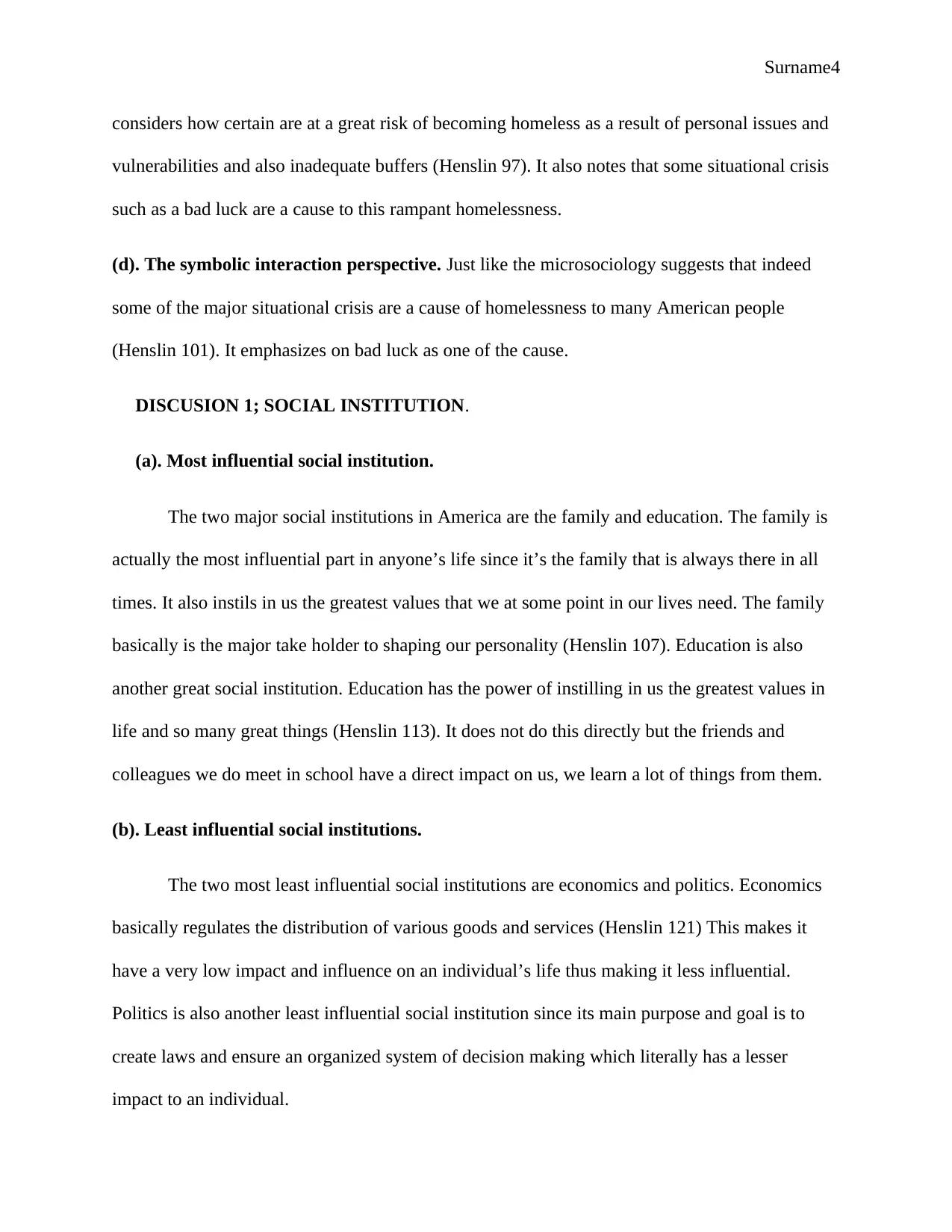
Surname4
considers how certain are at a great risk of becoming homeless as a result of personal issues and
vulnerabilities and also inadequate buffers (Henslin 97). It also notes that some situational crisis
such as a bad luck are a cause to this rampant homelessness.
(d). The symbolic interaction perspective. Just like the microsociology suggests that indeed
some of the major situational crisis are a cause of homelessness to many American people
(Henslin 101). It emphasizes on bad luck as one of the cause.
DISCUSION 1; SOCIAL INSTITUTION.
(a). Most influential social institution.
The two major social institutions in America are the family and education. The family is
actually the most influential part in anyone’s life since it’s the family that is always there in all
times. It also instils in us the greatest values that we at some point in our lives need. The family
basically is the major take holder to shaping our personality (Henslin 107). Education is also
another great social institution. Education has the power of instilling in us the greatest values in
life and so many great things (Henslin 113). It does not do this directly but the friends and
colleagues we do meet in school have a direct impact on us, we learn a lot of things from them.
(b). Least influential social institutions.
The two most least influential social institutions are economics and politics. Economics
basically regulates the distribution of various goods and services (Henslin 121) This makes it
have a very low impact and influence on an individual’s life thus making it less influential.
Politics is also another least influential social institution since its main purpose and goal is to
create laws and ensure an organized system of decision making which literally has a lesser
impact to an individual.
considers how certain are at a great risk of becoming homeless as a result of personal issues and
vulnerabilities and also inadequate buffers (Henslin 97). It also notes that some situational crisis
such as a bad luck are a cause to this rampant homelessness.
(d). The symbolic interaction perspective. Just like the microsociology suggests that indeed
some of the major situational crisis are a cause of homelessness to many American people
(Henslin 101). It emphasizes on bad luck as one of the cause.
DISCUSION 1; SOCIAL INSTITUTION.
(a). Most influential social institution.
The two major social institutions in America are the family and education. The family is
actually the most influential part in anyone’s life since it’s the family that is always there in all
times. It also instils in us the greatest values that we at some point in our lives need. The family
basically is the major take holder to shaping our personality (Henslin 107). Education is also
another great social institution. Education has the power of instilling in us the greatest values in
life and so many great things (Henslin 113). It does not do this directly but the friends and
colleagues we do meet in school have a direct impact on us, we learn a lot of things from them.
(b). Least influential social institutions.
The two most least influential social institutions are economics and politics. Economics
basically regulates the distribution of various goods and services (Henslin 121) This makes it
have a very low impact and influence on an individual’s life thus making it less influential.
Politics is also another least influential social institution since its main purpose and goal is to
create laws and ensure an organized system of decision making which literally has a lesser
impact to an individual.
Paraphrase This Document
Need a fresh take? Get an instant paraphrase of this document with our AI Paraphraser
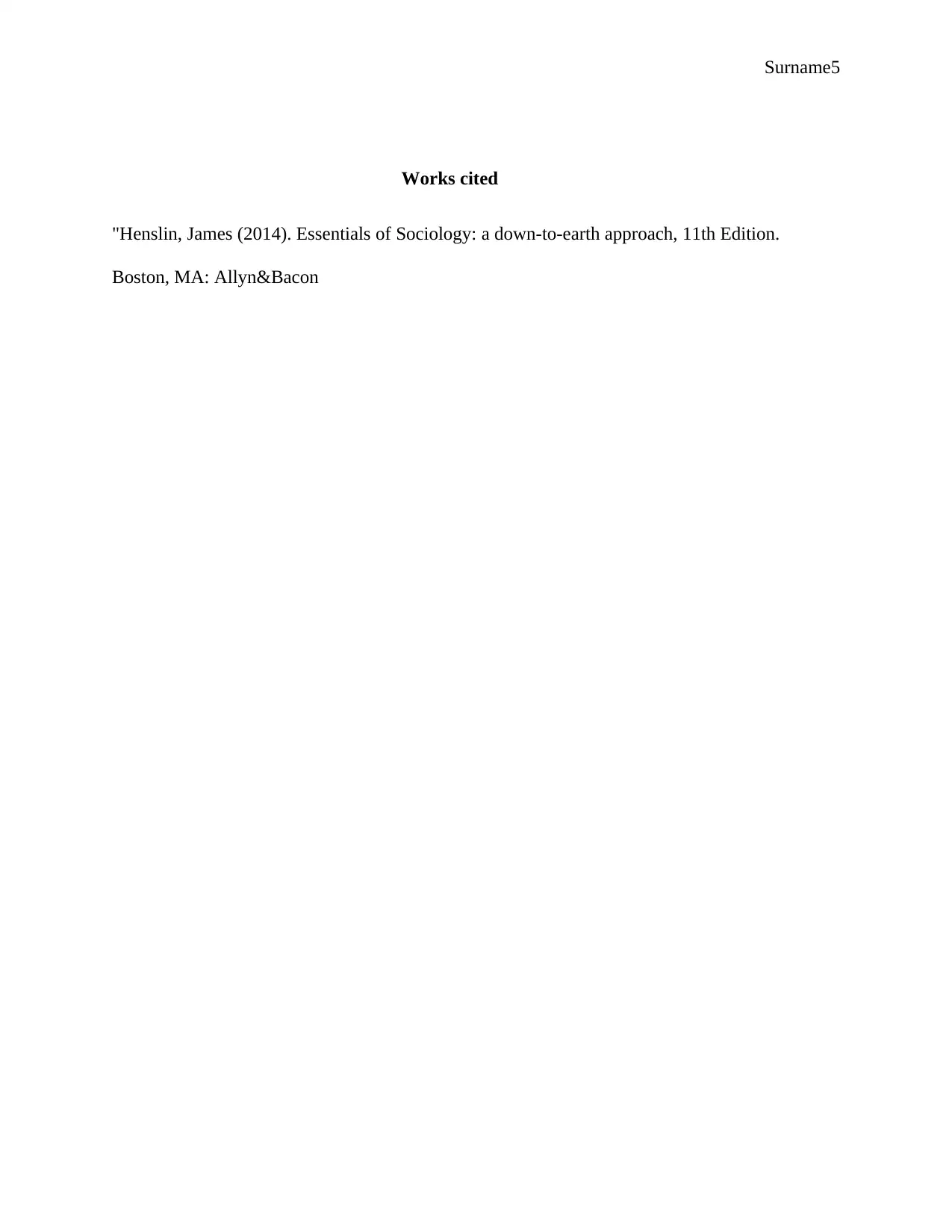
Surname5
Works cited
"Henslin, James (2014). Essentials of Sociology: a down-to-earth approach, 11th Edition.
Boston, MA: Allyn&Bacon
Works cited
"Henslin, James (2014). Essentials of Sociology: a down-to-earth approach, 11th Edition.
Boston, MA: Allyn&Bacon
1 out of 5
Related Documents
Your All-in-One AI-Powered Toolkit for Academic Success.
+13062052269
info@desklib.com
Available 24*7 on WhatsApp / Email
![[object Object]](/_next/static/media/star-bottom.7253800d.svg)
Unlock your academic potential
Copyright © 2020–2025 A2Z Services. All Rights Reserved. Developed and managed by ZUCOL.





